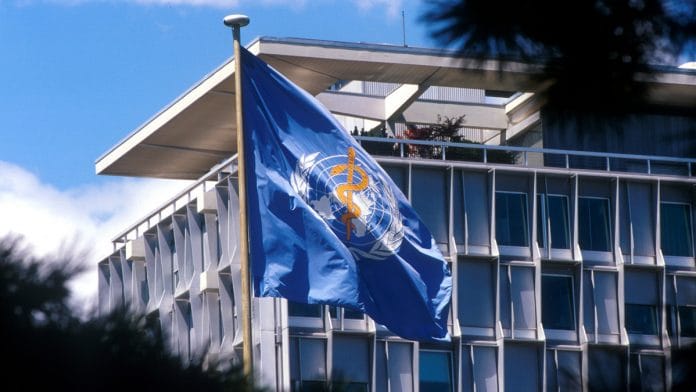New Delhi: US President Donald Trump Tuesday made a series of contradictory statements with regard to the World Health Organization (WHO).
First, he lashed out at the WHO by declaring he would “hold” their funding, and then said the decision is still under consideration.
Trump said the WHO seemed to be “China-centric” and that it got “every aspect” of the coronavirus pandemic “wrong”.
Trump, however, isn’t the only one criticising the WHO. Several leaders, columnists, and others have also criticised the WHO’s handling of China — where the virus had originated.
Japan’s deputy Prime Minister Taro Aso said the body should be renamed as the “Chinese Health Organization” as he accused it of toeing the China line on the pandemic.
But what exactly is the WHO, and why does it hold so much power when it comes to global health crises? ThePrint brings you the answers.
Also read: In fight against coronavirus, India has age on its side. Numbers show
A brief history of the WHO
Headquartered in Geneva, Switzerland, the WHO was founded in 1948 to coordinate health affairs within the United Nations. At the first World Health Assembly held that year, the organisation resolved to focus on malaria, tuberculosis, venereal diseases, maternal and child health, sanitary engineering, and nutrition.
It started off with $5 million and 51 member countries — all of whom signed its constitution. Now, it has 194 member countries, with a budget of $4.8 billion. The US is currently the biggest financial contributor to the WHO, and has been its active member for many decades.
Some of the WHO’s biggest achievements came in its early days.
In 1958, the erstwhile United Socialist Soviet Republic, or USSR, had proposed a WHO-led smallpox eradication programme. The disease was still endemic by 1966, especially in Africa and Asia.
The next year, in 1967, the WHO began its Intensified Eradication Program that focused on mass vaccinations, and it proved to be a huge success. By 1980, small pox was declared as eradicated from the world — the only disease to be classified this way.
Other successes and failures
In 1978, the WHO adopted the Declaration of Alma-Ata, calling on “urgent and effective national and international action to develop and implement primary health care throughout the world”.
The declaration was considered historic for identifying the role and necessity of primary healthcare in assuring health facilities for all.
The WHO has played a central role in global immunisation programmes against polio, measles and tetanus, among others. It is also the publisher of the World Health Report and the worldwide World Health Survey — both useful indices to measure performances of countries when it comes to their health infrastructure and delivery.
But the history of the organisation also reveals some serious shortcomings.
It has come under fire in recent years for its heavy bureaucratic framework, which has led to inefficiencies, inertia, and even “over reactions”.
During the 2009 H1N1 (swine flu) pandemic, the WHO was accused of overplaying the dangers of the virus and aligning with pharmaceutical interests.
As a consequence, member states bought billions of doses of vaccines that ultimately remained unused, leading to a wastage of resources and money. The organisation later admitted to have failed in communicating about it properly.
During the Ebola outbreak in 2013-2015, the WHO failed to sound the alarm over the virus, despite knowing about it. Thousands of lives were lost before the WHO could act.
Also read: The four stages of Covid-19 transmission & why India maintains it is not yet in stage 3
Handling of novel coronavirus pandemic
On 31 December 2019, the WHO’s China office was informed about cases of pneumonia of unknown etiology (unknown cause) detected in the Wuhan city of Hubei province.
Ever since, the WHO has worked to inform the world about the illness — called the novel coronavirus — and even earned the praise of global health experts initially for its transparent and swift approach.
It was the WHO that announced a global emergency due to the spread of the virus and later declared it a pandemic. It is raising $675 million to find a cure and spread awareness about the illness.
But questions were raised when its director Dr Tedros Adhanom Ghebreyesus praised China for the “speed with which [it] detected the outbreak”, and its “commitment to transparency”, even though China has a history of keeping its data under wraps and it is said to have even concealed the extent of the outbreak during the early stages.
The WHO maintained that masks only need to be used by those with symptoms, and travel bans are “ineffective” in curbing the spread of the virus. But other organisations such as the American Centre for Disease Control (CDC) differed with the WHO and have followed their own protocols. So have individual countries, including India, which has suspended travel and also advised people to wear masks when they step out of their homes.
‘Accomplice of China’
The WHO is now being called “China’s accomplice” in the battle against coronavirus, even as it is at the forefront of fighting its worldwide spread.
Calls for reform in the organisation have been raised for long as its actions have sometimes deviated from its core goals — as was the case with the 2009 swine flu and now with the novel coronavirus.
Despite the criticism, the WHO has pledged to keep fighting against the current pandemic.
“We cannot defeat this outbreak without solidarity. Political solidarity, technical solidarity, and financial solidarity,” WHO director Ghebreyesus had said in early February.
The virus has infected over 14 lakh people worldwide and left over 82,000 dead.
Also read: Modi’s India isn’t Mao’s China. Silly forecasts assume we’ll let corona kill millions of us






